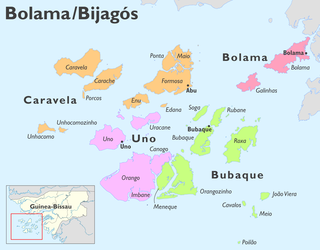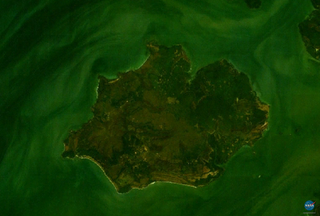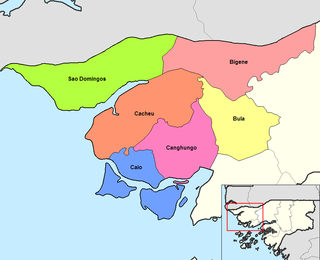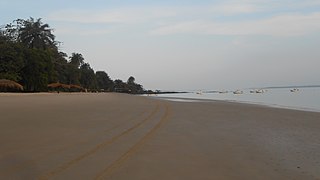
Bubaque is one of the Bijagós Islands in Guinea-Bissau, and is also the name of its main town. The island has a population of 6,427, while the town of Bubaque has a population of 4,299. The area of the island is 75 km2, it is 13.6 km long and 8 km wide.

Bolama is the main town of Bolama Island and the capital of the Bolama Region. Though once the capital of Portuguese Guinea, it has a population of just 4,819 and much of its colonial era architecture is in a state of severe decay. The town is almost surrounded by mangrove swamps and is now mostly known for its production of cashew nuts.

Orango is one of the Bijagós Islands, located 60 kilometres off the coast of mainland Guinea-Bissau. At 272.5 km2, it is the largest island in the archipelago. The island has a population of 1,250 ; the largest village is Eticoga. With the neighbouring islands Imbone, Canongo, Meneque and Orangozinho, it forms the Orango National Park. It belongs to the Uno Sector.
João Vieira is an island in the Bijagós Archipelago of Guinea-Bissau. Its population is 6. It is part of the João Vieira and Poilão Marine National Park. It lies 11 nmi (20 km) north-northeast of the island Poilão. Other nearby islands are Meio and Cavalos. The islands are important nesting grounds for sea turtles.

Galinhas is an island in the Bijagós Archipelago of Guinea-Bissau. Galinhas is located about 25 km southwest of Bolama town. The Canal de Bolama separates it from Bolama Island, the easternmost island of the group that lies close to the mainland. The area of the island is 50 km2, its length is 10 km and its width is 6 km.

Farim is a town of northern Guinea-Bissau. It sits on the north bank of the Farim/Cacheu River, about 215 km up the river from Cacheu. Population 8,661.

Bolama is an administrative region in Guinea-Bissau, consisting primarily of the Bijagós Archipelago of the country's southern coast, together with a small coastal strip centred on the coastal town of São João. It has an area of 2,624 km2. Its capital is Bolama, on the island of the same name. It is a coastal region covered with Mangrove swamps, rain forest and tangled forest and receives an annual rainfall of more than 1,000 mm (39 in).

There are 39 sectors of Guinea-Bissau which subdivide the regions. The sectors are further subdivided into smaller groups called sections ; which are further subdivided into populated places. Here are the following listed below, by region:

Caravela is the northernmost island of the Bissagos Islands of Guinea-Bissau, part of the Sector of Caravela, which also includes the islands Carache, Maio, Ponta and Formosa. The population of the sector is 4,263, the population of the island is 907. The area of the island is 128 km2, its length is 19.3 km and its width is 10 km. The island is heavily forested with mangroves. It has white, sandy beaches. Caravela has a small airfield. The island Carache lies to its southeast.
Pecixe is an island in Guinea-Bissau. It is a coastal island belonging to the Cacheu Region and the Caió sector. Its area is 167 km2. The island has a population of 3,207 ; the largest village is Cassaca. The language of the island is reported to be Mandjak, a language of Guinea-Bissau with over 72,000 speakers altogether. Jeta island lies to the west. It is 3 km off the mainland, about 50 km west of the capital city Bissau.
Formosa is an island in the Bissagos Islands, Guinea-Bissau, part of the sector of Caravela. Its area is 140 km2, its length is 19.9 km and its width is 10 km. It forms practically one island with Ponta and Maio, separated by creeks. The island has a population of 1,873 ; the largest village is Abú.

Roxa or Canhabaque is an island in the Bissagos Islands, Guinea-Bissau. It is part of the sector of Bubaque. Its area is 111 square kilometres (43 sq mi); it is 20 kilometres (12 mi) long and 11 kilometres (6.8 mi) wide. The island has a population of 2,478, divided over the villages Ambuduco, Ampucute, Ancanhozinho, Indenazinho, Ancaguine, Ancatipe, Angaura, Indena Grande, Ga-Cote, Inore, Ambena, Bine, Inhoda, Idjoue, Eboco, Meneque, Ancanam, Anghudjiga, Anghumba and Antchurupe. There is a lighthouse on the east side of the island, its focal height is 26 m (85 ft).

Uno is one of the Bissagos Islands off the coast of Guinea-Bissau, in the Atlantic Ocean. The land area is 104 km2 (40 sq mi), with a population of 3,324 (2009).

Orangozinho is an island in the Bissagos Islands, Guinea-Bissau, it is part of the Bolama Region and the Bubaque sector. Its area is 107 km2, its length is 19 km and its width is 11.8 km. It has a population of 706 ; the largest village is Wite. The island forms a part of the Orango National Park.

Carache is an island in the northwestern part of the Bissagos Islands group, Guinea-Bissau. It belongs to the Bolama Region and the sector of Caravela. Its area is 80.4 km2, the island is 18.7 km long and 7.3 km wide. It is separated from the island of Caravela by a narrow channel. The largest villages on the island are Binte and Ampintcha. Its population is 428.
Unhocomo is the westernmost island in the Bissagos archipelago of Guinea-Bissau. It forms part of the Sector of Uno. In 2009 its population was 678. It lies 15 km west of Uno.

Caió is a sector in the Cacheu Region of Guinea-Bissau. Its population is 12,696. The island Pecixe is part of the sector.
Bijago or Bidyogo is the language of the Bissagos Archipelago of Guinea-Bissau. Bidyogo is the "dominant mother tongue of the archipelago population", though it is not used in schooling there, a role that has been taken on Kriol since the 1990s. There are some difficulties of grammar and intelligibility between dialects, with the Kamona dialect being unintelligible to the others.

Rubane is one of the Bijagós Islands in Guinea-Bissau. The island has a population of 165. The island lies northeast of the larger island of Bubaque, across a narrow strait. It is part of the Boloma Bijagós Biosphere Reserve.

Bolama is the closest of the Bissagos Islands to the mainland of Guinea-Bissau. The island has a population of 6,024. It shares its name with its largest settlement, the town Bolama, which is the capital of the island and the Bolama Region. A causeway links the island to the Ilha das Cobras. Attractions on the island include sandy beaches and the abandoned ruins of the town of Bolama. It is known for its cashew nuts.











